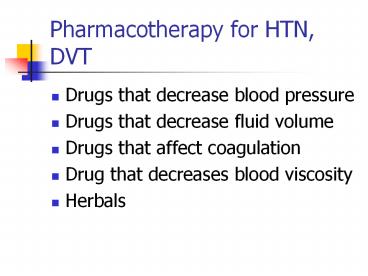Pharmacotherapy for HTN, DVT PowerPoint PPT Presentation
1 / 18
Title: Pharmacotherapy for HTN, DVT
1
Pharmacotherapy for HTN, DVT
- Drugs that decrease blood pressure
- Drugs that decrease fluid volume
- Drugs that affect coagulation
- Drug that decreases blood viscosity
- Herbals
2
Drugs that Decrease Blood Pressure
- Alpha-adrenergic blockersdoxasozin (Cardura)
- Beta-adrenergic blockersatenolol (Tenormin)
- Angiotensin Converting Enzyme Inhibitors
(ACEIs)enalapril (Vasotec) - Angiotension Receptor Blockers (ARBs)losartan
(Cozaar)
3
Drugs to Decrease BP contd
- Calcium-channel blockersdiltiazem (Cardizem)
- Centrally-acting sympatholyticsclonidine
(Catapres) - Vasodilatorsminoxidil (Loniten)
4
Alpha-BlockersPrototype doxasozin
- Note all generics end in sozin
- Action blocks alpha receptors in vascular smooth
muscle, causing vasodilation. - Side effects first dose syncope, orthostatic
hypotension, tachycardia, palpitations, nasal
congestion, impotence. - Nursing considerations Give at hs to minimize
risk of fainting. If 1st dose is given in daytime
or if dose is increased, instruct pt to remain in
bed for 3-4h. Pt is not to drive for 12-24h. Tell
pt to change positions slowly.
5
Beta-BlockersProtoype atenolol
- Note all generics end in lol
- Action blocks beta receptors, slows heart rate,
decreases oxygen demand - Side effects fatigue, dizziness, hypotension,
bradycardia, bronchospasm (do not use in
obstructive or restrictive respiratory diseases),
agranulocytosis, thrombocytopenia, ED, depression - Nursing considerations apical/radial pulse
before adm. Notify prescriber for Plt50, IO,
daily wts. Monitor BP.
6
ACEIsPrototype enalapril
- Note all generics end in -pril
- Action Suppresses renin-angiotensin-aldosterone
system prevents conversion of angiotensin I to
angiotension II. Dilates arterial and venous
vessels. - Side effects Insomnia, dizziness, hypotension,
dysrhythmias, proteinuria, renal failure,
agranulocytosis, neutropenia, cough, hyperkalemia - Nursing Considerations Monitor CBC, BP, P. If
pt is on diuretic tx, monitor for syncope
7
ARBsPrototype losartan
- Note all generics end in -sartan
- Action Blocks the vasoconstrictor and
aldosterone-secreting effects of angiotensin II - Side effects Dizziness, insomnia, CVA, MI,
dysrhythmias, cough, diarrhea, indigestion, renal
failure, angioedema - Nursing Considerations BP, P. Monitor for
edema, lytes, hepatic and renal function before
tx begins
8
CCBsPrototype diltiazem
- Action inhibits calcium dilates coronary and
peripheral arteries - Side effects HA, fatigue, drowsiness,
dysrhythmias, CHF, heart block, ARF - Nursing considerations Monitor VS, hold for
SBPlt90, Heart ratelt60 monitor ECG
9
Centrally Acting SympatholyticPrototype
clonidine
- Action stimulate alpha-receptors in the DNS to
suppress sympathetic flow to heart and vessels.
Suppresses cardiac output and causes
vasodilation. - Side effects dry mouth, sedation
- Nursing considerations Monitor BP and P. Tell pt
not to stop suddenlymay cause severe rebound
HTN. Administer at hs to minimize effects of
sedation. Contraindicated in pregnancy.
10
VasodilatorsPrototype minoxidil
- Action relaxes vascular smooth muscle,
especially arterioles and decreases systemic
vascular resistance (SVR). Usually given with BB
or diuretic. - Side effects fluid retention, reflex
tachycardia, orthostatic hypotension - Nursing considerations Assess BP, P before and
during tx. Monitor for edema and hear failure.
Tell pt to change positions slowly. And to report
muscle or joint aches or fever. May cause
excessive hair growth
11
Drugs that Decrease Fluid Volume
- Thiazide diureticshydrochlorothiazide (HCTZ,
HydroDIURIL)
12
Thiazide DiureticsPrototype hydrochlorothiazide
- Action Increases excretion of water, sodium,
chloride, and potassium in the distal tubule and
ascending limb of loop of Henle. - Indications Edema, HTN, diuresis, CHF
- Side effects Dizziness, weakness, fatigue,
hypokalemia, NV, anorexia, hepatitis, aplastic
anemia, pancytopenia, glucosuria, allergic
reaction (sulfa) - Nursing Considerations Assess daily wts, IO,
postural BPs, lytes, blood sugar
13
Drugs that Affect Coagulation
- Drugs interfering with the clotting
cascadeheparin sodium (no trade name),
low-molecular weight heparin (Lovenox) - Drugs that interfere with synthesis of Vitamin
K-dependent clotting factorswarfarin (Coumadin)
14
Anticoagulant 1Prototype heparin sodium
- Action prevents conversion of fibrinogen to
fibrin and prothrombin to thrombin - Indications Tx of pulmonary embolism, DVT
- Side effects fever, hemorrhage, rash,
thrombocytopenia, anemia, anaphylaxis - Nursing considerations Monitor PTT, CBC, signs
of hemorrhage and allergy. If given SQ, give in
abdomen. Do not aspirate or massage. Check labels
closely so as not to confuse concentrations.
15
Anticoagulant 2Prototype LMWH
- Action prevents conversion of prothrombin to
thrombin. More precise and predictable than
heparin - Side effects hemorrhage, bruising,
thrombocytopenia - Nursing considerations abdomen is best site for
SQ administration. Do not remove air bubble from
syringe before administration. Do not aspirate or
massage.
16
Anticoagulant 3Prototype warfarin
- Action interferes with blood clotting by
depressing hepatic synthesis of Vitamin
K-dependent coagulation factors - Indications prevention and tx of pulmonary
emboli, DVT - Side effects hepatitis, hemorrhage, WBC
effects, rash - Nursing considerations Monitor PT, CBC, and for
hemorrhage and occult blood in stools.
17
Trental (pentoxifylline)
- Action Decreases blood viscosity, increases
blood flow by increasing flexibility of RBCs - Indication Intermittent claudication
- Forms po, po XR
- Side effects HA, tremors, dizziness,
indigestion, NV, leukopenia - Nursing Considerations Watch BP if pt is on
antihypertensives. Assess for improvement in
activity with continued use.
18
Herbals
- Ingestion of Fish Oil/Omega-3 Fatty Acids has
been associated with lower BP readings in people
with hypertension - Hawthorne may be most commonly used herb for
treating HTN, but should not be used with other
antihypertensives and with cardiac glycosides

